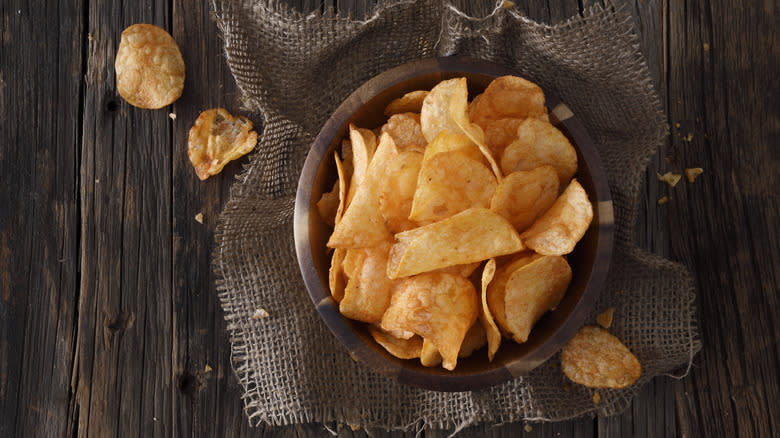Temperature Matters When Seasoning Homemade Potato Chips

What's better than a salty, crunchy, flavorful potato chip? A salty, crunchy, flavorful potato chip that's homemade, of course. But while the chip-making process is pretty simple overall, a few subtle steps can make a big difference in the final result. One has to do with the temperature of the chips when applying seasoning.
When making Mashed's homemade potato chip recipe, the ideal moment for seasoning comes as soon as the chips are removed from the oven and taken off the baking sheets. For those who choose to fry their chips instead, it's the point where they've just been removed from the fryer. This is when the chips are the hottest before any residual oil has dried and the chips have fully stiffened into their crunchy final form.
This is critical for several reasons. First, the remaining hot oil helps any seasonings adhere better to the chips instead of falling off, preserving more flavor. Meanwhile, any salt used in your seasoning mix will also help draw out any remaining water inside or on the surface of the chips, ensuring maximum crunch.
Read more: 41 Must Try Hot Sandwich Recipes
Don't Dawdle When Adding Flavor To Chips

Chips can cool fast when removed from the oven or fryer, though it's important not to season too quickly. Homemade chips will likely be quite hot when removed from our 375-degree F oven and coated with sizzling oil. In any case, it's vital to have your seasoning mix ready when your chips finish cooking. You can toss your chips and seasoning in a large bowl for the most even distribution or simply sprinkle it on top for more delicate chips.
As for your choice of flavor, that's up to you. Based on a Mashed survey, it's clear people are divided on what the best chip flavor is. Out of 74,000 responses, sour cream and onion is the favorite seasoning for about a third of snackers. Barbecue, salt and vinegar, and classic plain chips all earned about 20% each. More adventurous home potato chip makers can even try to replicate some of the most unique chip flavors to ever grace store shelves, like Lay's cinnamon bun or cappuccino chips, or Pringles' salt and seaweed variety.
In the end, no matter how you season your chips, the most critical factor remains getting the temperature right. It's a small factor that makes a massive difference in the end result.
Read the original article on Mashed.

